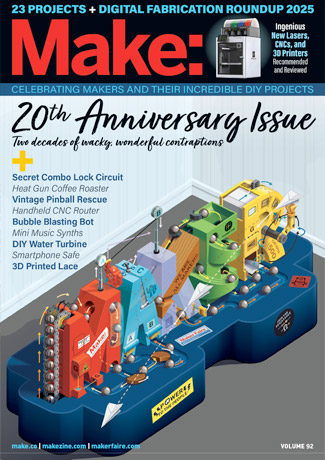Gareth Branwyn is a freelance writer and the former Editorial Director of Maker Media. He is the author or editor of over a dozen books on technology, DIY, and geek culture. He is currently a contributor to Boing Boing, Wink Books, and Wink Fun. His free weekly-ish maker tips newsletter can be found at garstipsandtools.com.
View more articles by Gareth BranwynOver on Make Build Modify, Justin has a video showing how he built a rack to hold all of his shop hammers. The rack is made from several sizes of angle iron stock, assembled with common shop tools, and fastened together using the hand-hammered rivets method.
Justin explains the project:
I decided to make a much-needed hammer rack for my shop. At first I was going to just cut the stock and weld all of the joints. But I’ve been playing around will different ways of fastening metal and implemented this makeshift rivet method.
I also decided that while I was fastening the metal by hand, maybe it would be in the spirit of the project to cut all of the metal by hand, too.
At the end of the project, I realized that it could have been completed with only a hammer, a drill, a hacksaw, and a few lag bolts for installation.
Welding would have been stronger, but I think that the rivets are strong enough for this purpose.
While the YouTube community gets a lot of well-deserved heat for being quick to whine, criticize, and troll, there is also a lot of encouragement and knowledge-sharing to be found amongst the “You suck!” and “It’ll never work!” comments. In the case of this project video, one commenter offered some advice to Justin on the riveting:
A fairly deep countersink would give your hand-hammered rivets a good bit more strength. The danger being with a straight bore that your rivet is spread too thin across the top. With a countersink you’re guaranteed a bit of depth on the grip.
Another commenter added that if he had chamfered the holes before sinking the rivets, it would have allowed the rivets to how into the holes more, seat better, and offer more strength to the joins.
Gareth Branwyn is a freelance writer and the former Editorial Director of Maker Media. He is the author or editor of over a dozen books on technology, DIY, and geek culture. He is currently a contributor to Boing Boing, Wink Books, and Wink Fun. His free weekly-ish maker tips newsletter can be found at garstipsandtools.com.
View more articles by Gareth BranwynADVERTISEMENT






